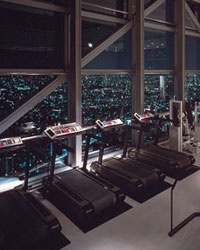 Courtesy of Park Hyatt Tokyo
Bring inspiration to your perspiration at these nine hotel gyms.
Courtesy of Park Hyatt Tokyo
Bring inspiration to your perspiration at these nine hotel gyms.
See our slideshow of the Best Hotel Gym Views.
From the 47th floor of the Park Hyatt Tokyo, sunbeams play off the perfect cone of Mount Fuji. Far below, Tokyo’s frenetic pace is reduced to a silent pulse of miniscule cars and people. You take another sip of water and lose yourself in the music emanating from the built-in speakers in the Bodysonic flooring. Is this the hotel’s presidential suite? The signature restaurant? Nope—it’s the Park Hyatt’s fitness center.
Your typical hotel gym may well be located in the basement, wedged somewhere between the boiler room and the broom closet. These deserted beefcake bunkers are usually the last place anyone wants to exercise. But some hotels have seen the light, elevating their gyms to dizzying new heights, with spectacular views to match.
For true gym-junkies, the view from the treadmill might seem irrelevant. But for those requiring a little encouragement, it can make all the difference. “If you want to start exercising again, a new environment can be a big positive because you won’t associate it with the baggage from the old gym,” says sports psychologist Sam Maniar, Ph.D. “It can then be used as a motivational springboard so you’ll be more likely to start exercising at home.”
Enter the welcoming environs of a new breed of hotel gyms and you’ll be met with high-tech machines, sensitive interior design, and remarkable panoramic vistas. Some gyms, like the Park Hyatt Tokyo’s, are so far from terra firma that their lofty position alone should be enough to raise the pulse. “It’s highly decadent to put a health club on top of a building, but if you’re stuck working out, the view might offer some reprieve,” says architect Mitchell Joachim, who created the concept of gyms floating on the water surrounding New York City. “Views provide people with a relationship with the outside world in terms of scale, position, and geography,” he says. “Take that away and the sense of confinement is overwhelming and cruel.”
Still, gyms shouldn’t replace all mirrored walls with windows. On the contrary, mirrors are essential for focusing on form when lifting weights. Maniar suggests that décor be dictated somewhat by activity. “When it comes to cardiovascular exercise, most people want to be distracted,” he says. “If they don’t habitually exercise, it can be boring or painful to start working out, and they often need something to occupy their minds.” An iPod or TV will suffice, but spectacular views offer far superior distractions.
What kind of distractions?How about snow-covered Alps from Milan’s Principe di Savoia or breaching whales from qualia, a luxury hideaway on Hamilton Island in Australia. According to Tom Oliveri, who manages the health club on the 27th floor of New York’s Millennium UN Plaza, “When the TV is on, people don’t like it. They always ask me to shut it off.” He blames the commanding views over New York’s East River and beyond.
But if a little natural light is all that’s needed to alleviate the funk of a basement sweatbox, why give over multimillion-dollar real estate to treadmills? Maniar explains that superficially, a health club may be all about fitness, but their true purpose is far broader: Through design, location, staffing, and marketing, everything about a gym is intended to build self-esteem as much as muscle tone. “When you feel good about the fact that you exercised, and you did it in a hotel’s gym, it has to be good for business,” he says.
Maniar also has an idea as to why some hotel gyms have risen to extreme heights. “We tend to associate higher floors with more successful people,” he says. Of course, high-end hotels are courting power brokers more than power lifters, so it makes sense that their health clubs be placed where their target clientele sees themselves—at the top of the corporate ladder. Sure it’s a stretch (what workout would be complete without one?) but with that kind of psychoanalysis, a basement gym may never look the same again.